Foundations and Trends R in Networking
Age of Information: A New
Concept, Metric, and Tool
Suggested Citation: Antzela Kosta, Nikolaos Pappas and Vangelis Angelakis (2017),
“Age of Information: A New Concept, Metric, and Tool”, Foundations and Trends R in
Networking: Vol. 12, No. 3, pp 162–259. DOI: 10.1561/1300000060.
Antzela Kosta
Dept. of Science and Technology
Linköping University, Sweden
antzela.kosta@liu.se
Nikolaos Pappas
Dept. of Science and Technology
Linköping University, Sweden
nikolaos.pappas@liu.se
Vangelis Angelakis
Dept. of Science and Technology
Linköping University, Sweden
vangelis.angelakis@liu.se
This article may be used only for the purpose of research, teaching,
and/or private study. Commercial use or systematic downloading
(by robots or other automatic processes) is prohibited without ex-
plicit Publisher approval.
Boston — Delft
�
Contents
1 Introduction
163
2 The Introduction of the Concept
166
2.1 Age of Information . . . . . . . . . . . . . . . . . . . . . 166
2.2 First Queue-theoretic System Abstractions . . . . . . . . . 171
2.3 Summary . . . . . . . . . . . . . . . . . . . . . . . . . . . 176
3 The Early Works
177
. . . 178
3.1 Sharing the System Among Multiple Traffic Streams
3.2 Basic Scheduling Through Queues
. . . . . . . . . . . . . 182
3.3 Peak Age of Information . . . . . . . . . . . . . . . . . . 188
3.4 Availability of Resources . . . . . . . . . . . . . . . . . . . 191
3.5 Packet Management . . . . . . . . . . . . . . . . . . . . . 201
3.6 Summary . . . . . . . . . . . . . . . . . . . . . . . . . . . 214
4 Subsequent Works and Extensions
216
4.1 Rate Control Optimization . . . . . . . . . . . . . . . . . 217
4.2 Packet Deadlines
. . . . . . . . . . . . . . . . . . . . . . 222
4.3 Optimizing Age, Throughput, and Delay . . . . . . . . . . 227
4.4 Summary . . . . . . . . . . . . . . . . . . . . . . . . . . . 229
�
5 Age as a Tool
230
5.1 Channel State Information . . . . . . . . . . . . . . . . . 230
5.2 Energy Harvesting . . . . . . . . . . . . . . . . . . . . . . 233
5.3 Scheduling . . . . . . . . . . . . . . . . . . . . . . . . . . 236
5.4 Summary . . . . . . . . . . . . . . . . . . . . . . . . . . . 238
239
6 Latest Contributions
6.1 Effect of Errors
. . . . . . . . . . . . . . . . . . . . . . . 239
6.2 Beyond Single-hop Communication . . . . . . . . . . . . . 241
6.3 Other Topics . . . . . . . . . . . . . . . . . . . . . . . . . 242
6.4 Summary . . . . . . . . . . . . . . . . . . . . . . . . . . . 245
7 Future Directions and Open Questions
246
7.1 Connection with Information Theory . . . . . . . . . . . . 247
7.2 Connection with Signal Processing . . . . . . . . . . . . . 248
7.3 Applications . . . . . . . . . . . . . . . . . . . . . . . . . 250
7.4 Summary . . . . . . . . . . . . . . . . . . . . . . . . . . . 251
Acknowledgements
References
252
253
�
Age of Information: A New
Concept, Metric, and Tool
Antzela Kosta1, Nikolaos Pappas2 and Vangelis Angelakis3
1Dept. of Science and Technology, Linköping University, Sweden;
antzela.kosta@liu.se
2Dept. of Science and Technology, Linköping University, Sweden;
nikolaos.pappas@liu.se
3Dept. of Science and Technology, Linköping University, Sweden;
vangelis.angelakis@liu.se
ABSTRACT
Age of information (AoI) was introduced in the early 2010s
as a notion to characterize the freshness of the knowledge
a system has about a process observed remotely. AoI was
shown to be a fundamentally novel metric of timeliness,
significantly different, to existing ones such as delay and
latency. The importance of such a tool is paramount, espe-
cially in contexts other than transport of information, since
communication takes place also to control, or to compute,
or to infer, and not just to reproduce messages of a source.
This volume comes to present and discuss the first body of
works on AoI and discuss future directions that could yield
more challenging and interesting research.
Antzela Kosta, Nikolaos Pappas and Vangelis Angelakis (2017), “Age of Information:
A New Concept, Metric, and Tool”, Foundations and Trends R in Networking: Vol.
12, No. 3, pp 162–259. DOI: 10.1561/1300000060.
�
1
Introduction
The concept of Age of Information (AoI) was introduced in 2011 in [31]
to quantify the freshness of the knowledge we have about the status of
a remote system. More specifically, AoI is the time elapsed since the
generation of the last successfully received message containing update
information about its source system. Utilizing a simple communication
system model, in a series of papers ([32], [33], [30], and [58]), the
first group of characterizations of the Age of Information metric had
appeared by 2012. Since then, AoI has attracted a vivid interest, with
over 50 publications, in the last six years 1.
The attention AoI has been receiving is due to two factors. The first
is the sheer novelty brought by AoI in characterizing the freshness of
information versus for example that of the metrics of delay or latency.
Second, the need and importance of characterizing the freshness of such
information is paramount in a wide range of information, communication,
and control systems. By now, age has been studied with considerable
diversity of systems, being as a concept, a performance metric, and a
tool.
1In this volume we take into consideration works that have been published no
later than June 2017.
163
�
164
Introduction
The purpose of this volume is to present a critical summary of
this first body of works performed on AoI and discuss future research
directions. Already at this early point we need to put down our first
disclaimer: we have chosen to treat the early works with significantly
more detail, going deeper in the derivations and presenting more results
and insights from them than we do with more recent works. The reason
for this is to achieve a tutorial nature in the volume, which can provide
a solid ground of the AoI as a concept. Moreover, the first works, which
we chose to present in more detail than the rest, aim to provide funda-
mentally new knowledge in the premise of maintaining information fresh
in a system. This basic goal opens up a wide range of communication
contexts that span from estimation and prediction, to applications such
as vehicular networks and information caching, to name a few.
With this in mind, we begin this volume presenting the AoI concept
as it was originally introduced. For this, we discuss the original models
of Kaul, Gruteser and Yates of [33], considering a system where a source
is transmitting packets containing status updates to a destination. The
analysis presented is based on a simple queueing model. Already in
that work the minimization of AoI was shown to be non-trivial for
the source sampling methods studied. However, it had already become
clear that timely updating a destination about a remote system is
neither the same as maximizing the utilization of the communication
system, nor of ensuring that generated status updates are received with
minimum delay. This is because utilization can be maximized by making
the source send updates as fast as possible which would lead to the
destination receiving delayed statuses because messages are backlogged
in the communication system studied. In this case, delay suffered by
the stream of status updates can be reduced by decreasing the rate of
updates. Alternatively, decreasing the update rate can also lead to the
destination having unnecessarily outdated status information because
of lack of updates.
AoI has spawned relevant performance metrics that are more tractable
such as the Peak Age of Information or the Cost of Update Delay, open-
ing even more research opportunities. Under the timely update context,
the relevant timeliness performance metrics should be kept at values
�
165
that ensure high freshness of information. Already the first AoI lower
bound had appeared in [33] and we discuss it in Section 2. We then con-
tinue the discussion on the early works of AoI as a performance metric
in Section 3, where we present the case of AoI for multiple sources, its
use in scheduling, and demonstrate packet management techniques that
have been employed. Section 4 treats AoI as a metric for rate control,
addresses the case of packets with deadlines, and presents an optimal
policy for optimizing age, throughput, and delay.
Keeping the AoI metrics low is of high interest when AoI is being
treated as a tool to facilitate the timely update of information that
will eventually improve performance metrics in different contexts. Con-
sider for example remote estimation; if the process under observation
consists of highly correlated data, then the frequency of generation and
transmission of updates can be significantly reduced without affecting
the timeliness of the information at a remote receiver. In Section 5, we
discuss three domains in which AoI has been treated as a tool: Channel
State Information (CSI) estimation, energy harvesting, and scheduling.
Recent works that have appeared in the time of writing of this volume
have been categorized and treated in Section 6. Finally, in Section 7,
we provide a brief discussion of indicative future topics on which the
AoI can contribute. The topics we cover there are not a complete list,
as there is an immense wealth of possible problems associated with the
notion of timeliness as captured by age, in the form of either a tool, a
performance metric, or even a concept.
�
2
The Introduction of the Concept
With the introduction of Age of Information (AoI) in [31] and the
subsequent works of Kaul, Yates, and Gruteser, it became clear that
this new concept is novel compared to, at that time, existing measures of
information timeliness. Based on the seminal work of [33], in this section
we give to the reader the fundamentals of AoI for a status update system
under the queueing models assumed therein. As we already noted in the
introduction, we provide a good level of detail, for this first work. This
is to give solid insight and background to the reader and also to reflect
the value of the contribution to the topic of information timeliness.
2.1 Age of Information
Consider a system comprising two nodes. A stochastic process X(t) is
observed by the source node, that extracts samples. These are assumed
to carry information about the status of the process at the source node.
Assuming this status information is needed at the other node, each
collected sample needs to be transmitted over a communication link to
that destination. At the transmitter of the source node there is a buffer
which stores the samples in the form of packets containing (i) the value
166
�
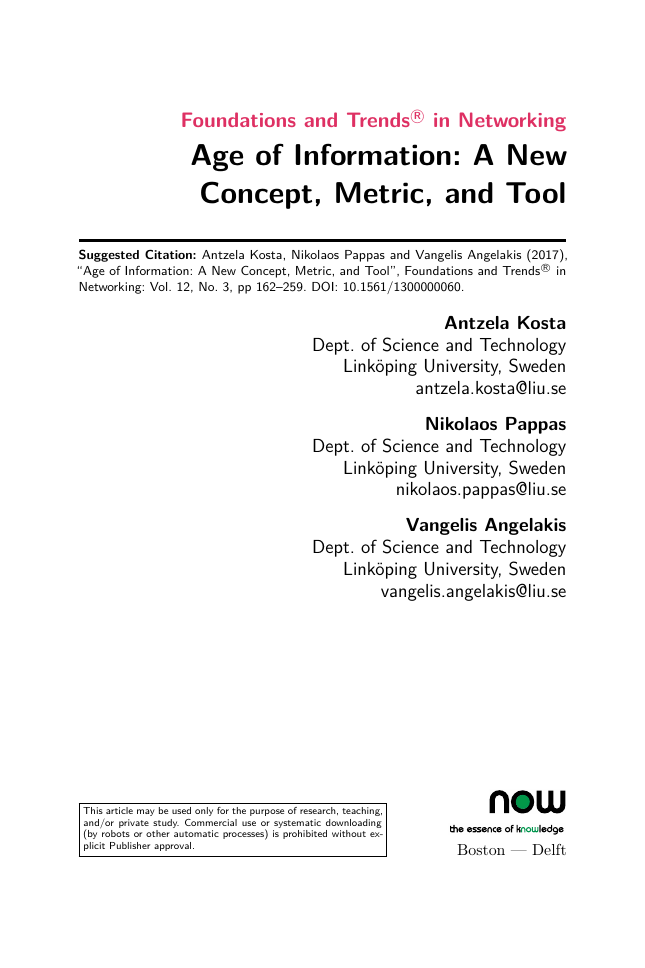
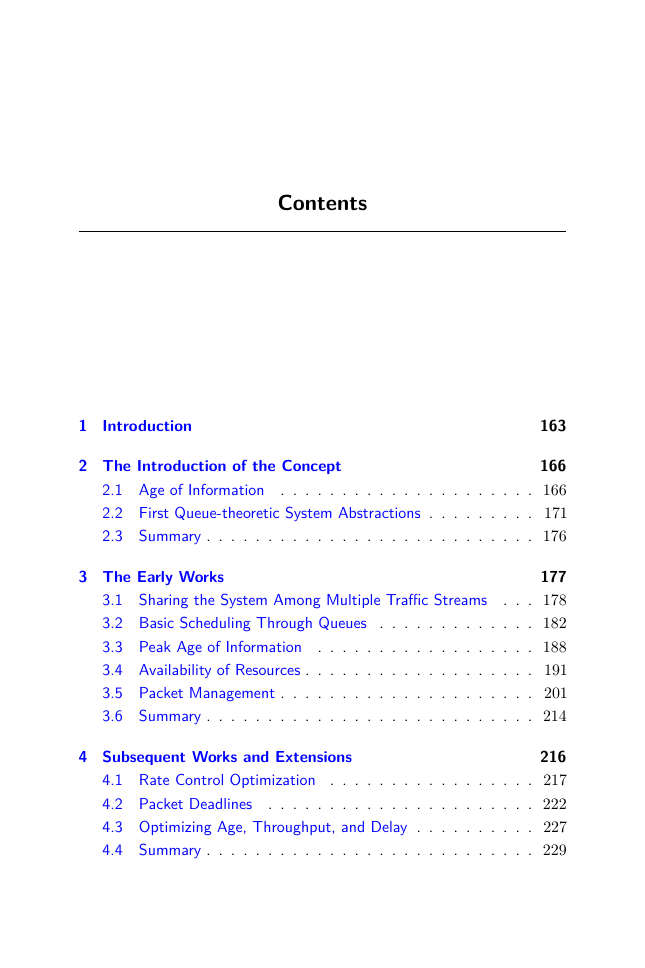
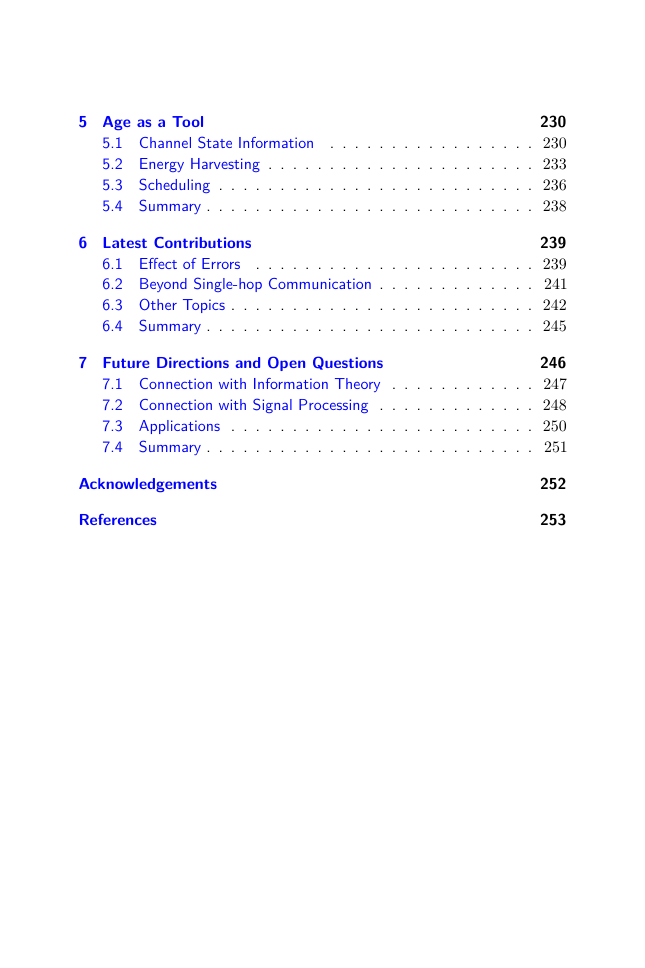



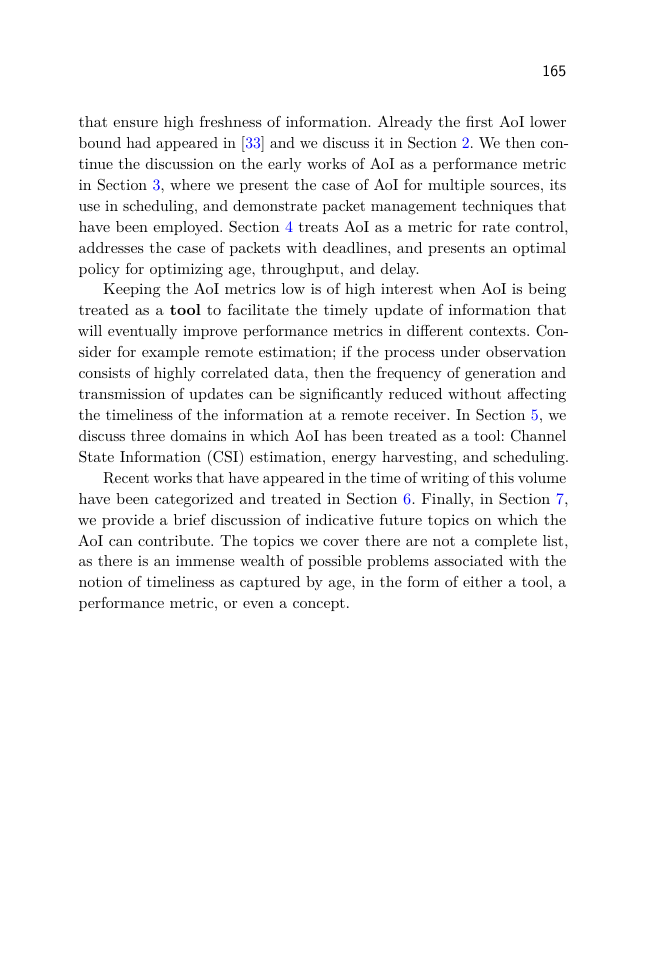
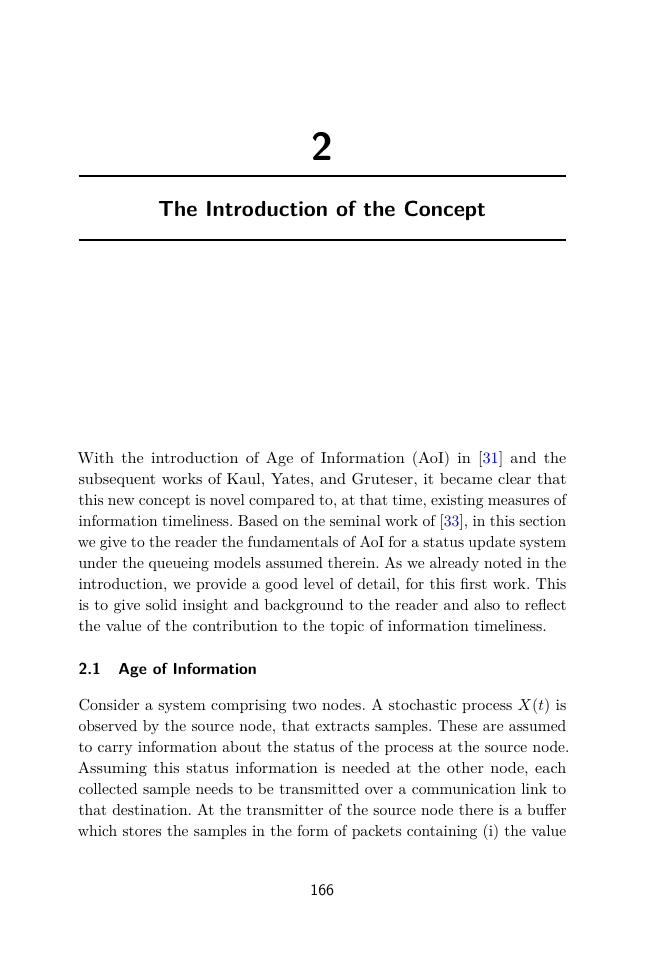








 2023年江西萍乡中考道德与法治真题及答案.doc
2023年江西萍乡中考道德与法治真题及答案.doc 2012年重庆南川中考生物真题及答案.doc
2012年重庆南川中考生物真题及答案.doc 2013年江西师范大学地理学综合及文艺理论基础考研真题.doc
2013年江西师范大学地理学综合及文艺理论基础考研真题.doc 2020年四川甘孜小升初语文真题及答案I卷.doc
2020年四川甘孜小升初语文真题及答案I卷.doc 2020年注册岩土工程师专业基础考试真题及答案.doc
2020年注册岩土工程师专业基础考试真题及答案.doc 2023-2024学年福建省厦门市九年级上学期数学月考试题及答案.doc
2023-2024学年福建省厦门市九年级上学期数学月考试题及答案.doc 2021-2022学年辽宁省沈阳市大东区九年级上学期语文期末试题及答案.doc
2021-2022学年辽宁省沈阳市大东区九年级上学期语文期末试题及答案.doc 2022-2023学年北京东城区初三第一学期物理期末试卷及答案.doc
2022-2023学年北京东城区初三第一学期物理期末试卷及答案.doc 2018上半年江西教师资格初中地理学科知识与教学能力真题及答案.doc
2018上半年江西教师资格初中地理学科知识与教学能力真题及答案.doc 2012年河北国家公务员申论考试真题及答案-省级.doc
2012年河北国家公务员申论考试真题及答案-省级.doc 2020-2021学年江苏省扬州市江都区邵樊片九年级上学期数学第一次质量检测试题及答案.doc
2020-2021学年江苏省扬州市江都区邵樊片九年级上学期数学第一次质量检测试题及答案.doc 2022下半年黑龙江教师资格证中学综合素质真题及答案.doc
2022下半年黑龙江教师资格证中学综合素质真题及答案.doc